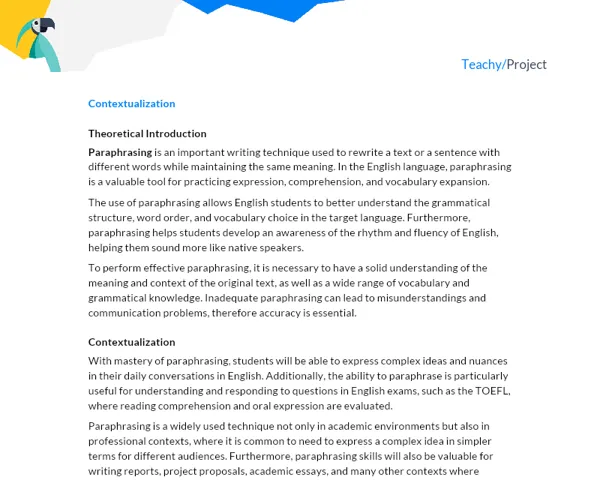Contextualization
Phrasal verbs are very common structures in the English language, formed by the combination of a verb with a preposition or an adverb. They are widely used in all communication contexts, especially in everyday speech. Understanding the concept and proper use of phrasal verbs is crucial to mastering the English language, as they can completely change the meaning of a sentence depending on the context.
There are numerous phrasal verbs and many of them can have multiple meanings, which gives great richness and versatility to the English language. Therefore, it is essential to study them, practice, and become familiar with their use in different contexts. For this, it is indispensable not only to understand the theory but also to apply it in practice, in real situations.
Introduction
In this project, we intend to deepen our understanding of phrasal verbs in order to better understand how they are formed, how they should be used, and what is the impact of their different applications. As part of this study, we will develop practical activities involving the use of phrasal verbs in real situations.
This is also an excellent opportunity to practice teamwork, collaboration, and time management, as each of you will be responsible for a part of the project. Furthermore, the project is an opportunity to further improve your English communication skills, as you will need to use the language to communicate with each other and with others.
Practical Activity
Activity Title: "Phrasal Verbs in Action"
Project Objective:
The objective of this activity is to provide a deep and practical understanding of the use of phrasal verbs in real communication situations. The activity involves creating a short video, in the format of a theatrical piece, using as many phrasal verbs as possible.
Detailed Project Description:
Each group of students will be responsible for building the script of a short theatrical piece, set in a context where the use of phrasal verbs is common (for example, an office, a house, a school, a restaurant, etc.). The script must incorporate at least 20 different phrasal verbs, used correctly in context.
After writing the script, students must act and film the theatrical piece, ensuring that pronunciation and intonation are as correct as possible. The video should not exceed 15 minutes in duration.
Necessary Materials:
- Pencil and paper (to sketch the first version of the script)
- Computer (to create the final version of the script)
- Camera or smartphone (to film the piece)
- Accessories and costumes (according to the script's needs)
Detailed Step-by-Step:
-
Gather the group and discuss the setting and plot of the piece (it should be simple but interesting).
-
Sketch the script on paper, ensuring the use of at least 20 phrasal verbs.
-
Research and discuss the meaning and correct application of each phrasal verb used.
-
Create the final version of the script on the computer.
-
Rehearse the piece, paying attention to pronunciation and intonation.
-
Film the piece.
-
Watch the video and make necessary edits.
Project Delivery:
Students must deliver:
-
The script written in English.
-
The short video of the piece, with English subtitles to confirm the correct use of phrasal verbs.
-
A written report containing:
-
Introduction: Should explain the chosen setting and plot for the piece, justifying why they are relevant for the use of phrasal verbs. Additionally, it should explain the relevance of studying phrasal verbs for English communication.
-
Development: Should explain the theory about phrasal verbs, with a detailed discussion of each of the 20 phrasal verbs used in the piece. Furthermore, it should describe in detail the process of creating the script and filming the piece.
-
Conclusions: Should reflect on the experience of carrying out the project, describing the challenges encountered, the skills developed, and the lessons learned about the use of phrasal verbs.
-
Bibliography: Should list the sources consulted for the project, including web pages, books, videos, etc.
-
The evaluation will be based on both the video and script, as well as on the students' ability to describe and reflect on the learning process in their report.
The delivered items will be interconnected, as the report complements the video and script, describing the theory behind the phrasal verbs used and the project creation process. Thus, through the practical activity, students will apply the theory of phrasal verbs, and by writing the report, they will make a deep reflection on their learning.



